End of the line for Expo legal challenge
August 7, 2013
A long-running legal challenge to the Exposition Line light rail project, now under construction from Culver City to Santa Monica, was stopped in its tracks this week by the California Supreme Court.
In a 6-1 decision, the court ruled against the group called Neighbors for Smart Rail, which contended in its lawsuit that the environmental reviews for the second and final phase of the Expo project had been inadequate.
The high court said the environmental information considered was sufficient, although they did agree with the plaintiffs on one point: they found that the project should have considered 2015 conditions—not 2030 conditions—in assessing potential impacts. But even so, the justices found, the process “did not deprive the agency or the public of substantial relevant information on those impacts.”
Expo backers hailed the ruling as the last chapter in a lengthy legal battle and said it clears the way for completion of the project, which will provide a transit alternative on a route that for the most part parallels the heavily-congested 10 Freeway.
“With this litigation now behind us, Westside residents can look forward to an exciting new public transit option when the Expo Line is scheduled to open in 2015,” Supervisor Zev Yaroslavsky, a member of the Exposition Light Rail Construction Authority board, said in a statement.
The high court ruling comes after two lower courts also rejected Neighbors for Smart Rail’s arguments. An injunction that would have stopped work on the project while the Supreme Court considered the group’s appeal was turned down in November, 2012.
Construction has been continuing at a brisk pace since then.
“We were free to move forward, and as a result we were able to construct about almost 50% of the project,” said Samantha Bricker, the construction authority’s chief operating officer. “The contractor is moving full steam ahead.”
“I think it’s a win for future riders,” she added, “as the project will be able to be delivered, as it stands right now, on time and on budget.”
Mike Eveloff, a board member of Neighbors for Smart Rail, said the group is continuing to explore its legal options.
“We’re in the weird position of being right on the law but I really think the court was hesitant to stop a big project,” he said. Meanwhile, he added, the organization “stands ready now, as we always have been, to talk about issues outside the legal process” to address its traffic concerns.
The initial phase of the Expo Line, between downtown Los Angeles and Culver City, opened last year to high ridership. When the second, final phase to Santa Monica is complete, Expo will make it possible to travel between downtown L.A. and Colorado Avenue and 4th Street in Santa Monica in 46 minutes.
Posted 8/7/13
DCFS under microscope again
June 26, 2013
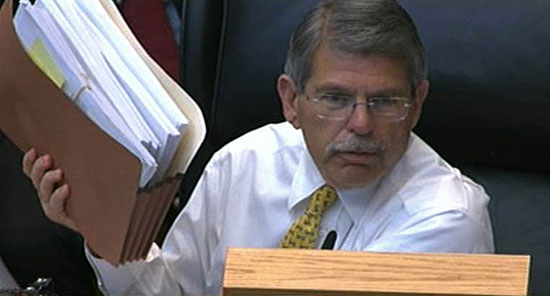
Supervisor Yaroslavsky, arguing against a new commission, says now is the time for action, not more recommendations. Here, he displays five years worth of board motions to examine DCFS operations.
Faced with another controversy over the failure of social workers to remove a child from a dangerous home, a divided Los Angeles County Board of Supervisors this week approved the creation of a blue-ribbon panel to investigate the Department of Children and Family Services and recommend reforms—the latest in a series of examinations stretching back decades.
The board’s action, on a 3-2 vote, follows the death last month of 8-year-old Gabriel F. of Palmdale, who was allegedly tortured by his mother and her boyfriend, both of whom are being held on murder charges. Social workers had earlier received multiple reports of abuse and neglect involving Gabriel, only the most recent child fatality to generate headlines and public outrage over the years.
The push for an independent panel came from Supervisors Mark Ridley-Thomas and Michael D. Antonovich and is modeled after the Citizens’ Commission on Jail Violence, which last year recommended dozens of reforms to curb brutality by sheriff’s deputies assigned to the county lockup. Its members, who included former judges, prosecutors and a prominent pastor, were appointed by the Board of Supervisors, who’ll also pick the new panel.
During Tuesday’s meeting, all five supervisors expressed deep frustration over the tragedies that have continued to plague DCFS and have prompted numerous management shakeups and hundreds of recommended reforms from oversight bodies. But the supervisors broke ranks on how best to achieve the foremost goal of keeping youngsters safe, with Ridley-Thomas, Antonovich and Gloria Molina voting for the commission and Zev Yaroslavsky and Don Knabe voting against it.
The proponents argued it was time for a fresh look by a group of independent, highly-respected individuals, who’d be given the authority to examine not only DCFS but other local agencies with which it interacts. The opponents, meanwhile, argued that DCFS’s director, appointed a little more than a year ago, already has made strides—including the adoption of a new strategic plan and training curriculum—and should not be distracted from the job at hand at a critical moment for the department.
Here are condensed excerpts of what each had to say, along with the edited remarks of DCFS Director Philip Browning:
Mark Ridley-Thomas
“Since 2008, there have been over 100 motions on our respective parts. Our collective effort is well documented. But when the time comes to turn our collective will into effective actions, unfortunately we have fallen short. There are times when government is unable to transcend a stagnant set of circumstances. Status quo needs to be altered. And so by establishing a blue-ribbon commission, we can finally get down to why these recommendations have not been implemented and understand what needs to be done. The commission is not intended to re-invent the wheel. Rather, the intent is to get the wheels turning and DCFS and related agencies moving forward. The blue ribbon commission will serve a very distinct role. Some have argued that we already have a children’s commission, so there’s no need for a blue ribbon commission. I would just simply say commissions can and do make governance more dynamic. They are less likely to be politicized and more inclined to be singularly focused, clinical in their pursuit and, therefore, have the opportunity to add significant value… particularly for this population that is so clearly vulnerable.”
Zev Yaroslavsky
“There isn’t a member of this board that doesn’t care deeply about the children who are our responsibility. Nothing makes me more angry than to see a child suffer anywhere, whether it’s in L.A. County, or on my block or in any part of the world. But the question is: how do you get it done? I can almost verbatim tell you what the commission report will say: ‘You’ve got to hire a lot more social workers.’ ‘You’ve got to have more accountability and more transparency.’ All of the kinds of things we have asked our current director to do. And we need at some point to let the current director breathe and do his work under careful scrutiny and accountability by the board. I’m, as many of you know, an adherent of John Wooden, the former UCLA basketball coach, who had a great line, among many great lines, which is: “Don’t mistake activity for achievement.” I think our challenge now is to execute what we know needs to be done. If we had never done this before, if there had never been a study of DCFS before, if there had not been a barrage of state audits before, had there not been a CSIU [investigative unit], then I would say a blue-ribbon commission is the way to go. But it’s ‘activity.’ And whether there’s achievement remains to be seen.”
Gloria Molina
“Very frankly, we’re not finding a solution [to child deaths]. And I wish it were just a problem in L.A. County. When you look at it across-the-board, whether you’re in Chicago, New York, San Francisco, you have the same issues: how to handle it and what we’re doing. There must be something that we’re missing. And so having a set of fresh eyes look at that is a good thing because I know I would be willing to accept a new set of recommendations. I really think that everything in that department has to change and has to change dramatically—everything from training our social workers to hiring our social workers to bringing accountability and, more importantly, to training our managers [who] in most instances can’t manage anything. But I applaud that we are moving forward in this direction. Until the blue ribbon commission concludes its review and analysis and this board acts upon its recommendations, it is the responsibility of this board…to immediately ensure this department continues to provide safety for children under their supervision.”
Don Knabe
“The minute something goes wrong, what do we do? We have another reaction to the media. We have another commission. We have another set of 99½ recommendations. Another rehash of everything we know that’s on the table. I think we’re all tired of hearing recommendations. We already know what needs to be fixed. We all want action and the greatest fear is that our department, DCFS, will come to a screeching halt because we are drowning in recommendations and losing that direction. And this blue ribbon commission would bring it to a total halt…What are they going to tell us that we don’t already know? After all the other recommendations and all of the advice that we have received over the years, what is sorely lacking is the refusal to set aside the many distractions and just get the job done. We must send a message as a board of zero tolerance of any action that exposes our children to harm. Another commission, I don’t think personally, will address those problems or set us on a path in the future. Another commission will just be a distraction to the very, very important work at hand.”
Michael D. Antonovich
“Just for the record, this motion [for a commission] does not inhibit the Department of Children and Family Services from moving forward with the implementation of their strategic plan and some of the most critical components, including the revamping of the training curriculum, policy manual rewrite and staffing reorganization. But what it does do is focus on a very serious issue and brings to a head the problem with recommendations.”
Philip Browning, director DCFS
“In my 40 years of public, private, military service, I’ve never turned down any help and I don’t intend to today. I do believe that there is some value in having a set of fresh eyes look at things. I know I learn something new every day. I do believe also that it’s critical that we have individuals [on the panel] who are knowledgeable, professional, independent, have no conflict of interest in order to really move this department forward. We’ve had some tragedies lately that are just unspeakable. We’re going through a process of investigations and hopefully we’ll get to a conclusion pretty soon. The most important thing I think I’d like to leave you with is that safety, in my opinion, is our primary goal. It’s job one for us. Frankly, most of the situations that don’t end up well don’t occur in foster homes or group homes. They occur when we’re trying to keep children in their families. And that is a very, very tough job. And it is one that they often don’t get thanked for.”
Posted 6/27/13
End of the road for Metro freeloaders
June 13, 2013
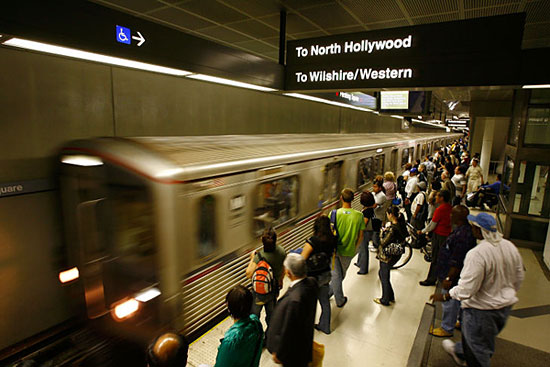
Starting next week, gates on L.A.'s subway system will be locking for good after years of debate and tests.
If you lock it, they will pay.
After extensive testing of latched turnstile gates and rollout of a new TAP card fare payment system, Los Angeles’ long, free trip on a subway without barriers is finally reaching the end of the line.
Next Wednesday, the subway gates at Union Station will be locked as a new era of public transportation rolls out in L.A., following more than two decades on an honor system that critics say unfairly penalizes paying passengers while leaving millions of dollars in revenue on the table.
David Sutton, Metro’s deputy executive officer in charge of the gate-latching project, said the lengthy testing period has been “a real eye-opener,” with consistent results in every test location: fewer boardings but a lot more paying customers using TAP cards.
“The data doesn’t lie,” Sutton said. “When we latch gates, we see less riders, more TAPs, more [vending machine] activity and more revenue.”
In 30 tests at Metro stations conducted earlier this year, sales at ticket vending machines spiked by nearly 30%, with 6,919 additional passengers paying to board trains, compared to the normal volume of paying passengers at each location.
Trains were less crowded because 14% fewer riders got onboard.
And as gate-latching tests intensified and enforcement was heightened, it seemed to create a lingering deterrent to would-be fare beaters. From October through December of 2012, fare evaders made up an estimated 18% of subway riders; from January through April of this year, with testing underway, that number dropped to 13%. So-called “fare checks” by sheriff’s deputies or security officers more than doubled—from 36,588 in October to 74,482 in April. And citations went through the roof, from 881 issued in October to 2,451 in April.
Overall, the testing results suggest that the agency could be able to recover between $6 million and $9 million annually in lost revenue once the subway and existing light rail gates are latched system-wide.
Supervisor and Metro Director Zev Yaroslavsky, a leader in efforts to get the gates latched, has made the case that it’s more than just a matter of money.
“It’s not fair to those people who pay to have a significant percentage of people who don’t pay,” he told the media last month. “The credibility of the enforcement system is undermined. It’s human nature to say, ‘If he’s getting away with it, why should I pay?’ ”
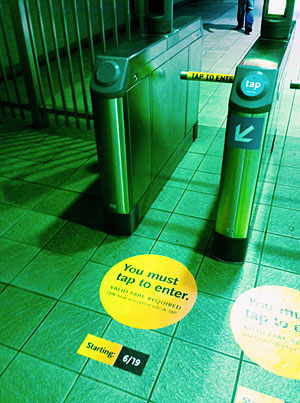
No tap-dancing around it: It will be mandatory to TAP to enter subway gates at Union Station starting Wednesday. Photo/Metro's The Source
It’s been more than 20 years since L.A.’s first subway—the Red Line—opened on an initial stretch of 4.4 miles. And it was five years ago that Metro’s Board of Directors voted to install gates in the subway and some light rail stations, citing security concerns and revenue losses of an estimated $5.5 million a year due to fare evasion.
“Metro remains the only subway operator in the country to operate a barrier-free system,” Yvonne B. Burke, then a Los Angeles County supervisor and Metro board member, said at the time. “That freedom has come at a significant cost to the agency’s bottom line as a result of fare scofflaws.”
Next week’s latching of the first subway gates can be seen as a coming of age moment in the progression of L.A.’s public transit system, which has grown exponentially in recent years and moved from comedian’s punch line to nationally-recognized point of pride.
But getting from there to here has been anything but an express trip when it came to getting the turnstiles locked.
One big stumbling block was the move from paper tickets to the TAP cards needed for passengers to be able to open locked gates. The transition initially prompted widespread confusion and complaints among would-be users, particularly seniors unable to find a way to buy their reduced-priced tickets in the new TAP system. New signs were installed and instructions on vending machine screens were retooled to simplify the process.
Regional transit agencies also needed to be recruited to join the TAP system; by the end of next year, 24 providers will be onboard. Integrating Metrolink passengers’ paper tickets with the TAP system proved to be a special challenge. Eventually, a special chip embedded in Metrolink tickets was developed so that passengers on the commuter rail system can get through locked gates when transferring to a Metro subway or light rail line.
A final test will be run Friday at Union Station, before the Red and Purple lines there are permanently latched on Wednesday, June 19. After that, work will begin on individual subway stations, with locked gates expected to be in place at all Red and Purple line stations by the end of August.
From there, the process moves to the transit system’s light rail stations, which cannot be completely locked because not all of those stations are equipped with gates. Light rail stations with gates on the Gold Line will be latched in October, on the Green Line in December and on the Blue Line in January, 2014.
Metro’s Sutton said the agency has heard some complaints during the lengthy gate-latching testing process but has received far more positive comments, chiefly along the lines of:
“Thank God. Why did you wait so long?”
Posted 6/13/13
Historic bash for Natural History Museum
May 30, 2013
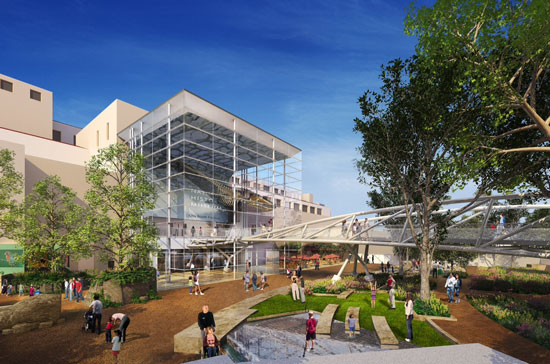
An artist's rendering of the Natural History Museum's new entry, with a fin whale skeleton suspended above.
Los Angeles was a hard-partying hick town when top-hatted civic leaders opened its first museum, toasting it with water from the then-day-old Los Angeles Aqueduct. The fairground where the new landmark stood had been a nest of saloons and gamblers. L.A. was so culturally young that, for its first acquisition, the museum touted a goldfinch nest from the San Gabriel River bottom.
But a century can make such a difference.
On June 9, the Natural History Museum of Los Angeles County will kick off its centennial with a day and night of hoopla in the rowdy ex-fairground that is now called Exposition Park. The festivities—with kid-friendly activities, food trucks, garden tours, live music, scientists and a nighttime concert by DEVO—will not only honor one of the nation’s largest and best-known natural history museums, but also will mark a milestone in the decade-long renovation and restoration.
The museum’s hallmark 65-foot fin whale will welcome guests from the top of a dramatic new glass entrance. Two Expo Line Metro stops will ferry visitors who prefer to arrive via L.A.’s burgeoning mass transit system.
A 3.5-acre Nature Garden will blossom outside a companion, state-of-the-art Nature Lab, where visitors can study wildlife, see it in action and then collaborate with science lovers region-wide in crowdsourced “citizen science” projects. Nearby, the museum’s acclaimed new Dinosaur Hall and award-winning Age of Mammals exhibits, both already opened, will be joined in July with the unveiling of the renovation’s final piece, “Becoming Los Angeles,” a permanent installation on the development of Southern California.
Meanwhile, visitors will be able to get a local history fix in the halls and rotunda of the 1913 building, which is on the National Register of Historic Places, and which has been restored and seismically strengthened.
“If you haven’t visited the Natural History Museum in a while, you should be prepared to find a vastly different institution,” says President and Director Jane Pisano. “This is a museum that has transformed itself.”
Pisano says the remodel arose from a change of philosophy at the museum.
“The old philosophy was very typical of natural history museums everywhere,” she says. “It was all about us—how we do research, how we take care of collections—and we changed that mission to focus on the visitor.”
The new aim, she says, is not to be “a book on a wall,” but to inspire wonder and a sense of discovery and responsibility in those who come to the museum. “We were doing a good job on wonder, but not so well on discovery and least well on inspiring a sense of responsibility for the natural world.”
Nor, she says, was the museum working as well as it could with Southern California’s natural landscape.
“There are very few cities that have the kind of climate we have,” she noted. So with the help of a new, county-funded garage that has consolidated parking, acres of paved land were transformed into wildlife habitat and gardens. Meanwhile, the building’s grand architecture was tweaked to create an easier flow between indoor and outdoor wonders.
Now visitors can take in the museum’s longstanding highlights—the dinosaur bones, the marine fossils—but also enjoy workshops led by master gardeners in the edible garden and unleash their kids in a “Get Dirty Zone.” The remodel also has set the stage for a long-term “citizen science” study of local biodiversity that museum experts expect to stretch throughout the Los Angeles Basin.
“This is a place where living things will come in and we can appreciate them in the wild,” says Karen Wise, the museum’s vice president of education and exhibits. “We don’t have to just have dead things on display.”
The new Natural History Museum isn’t the only cultural institution in Southern California to be reimagining the museum experience ways that are more authentic to L.A. The Los Angeles County Museum of Art under Director Michael Govan also has taken a more indoor-outdoor approach with installations such as Michael Heizer’s “Levitated Mass” and Chris Burden’s “Urban Light” on its campus. In fact, on the same day as the Natural History Museum celebration, LACMA will unveil a proposed architectural remodel that would make the county’s 50-year-old art museum literally transparent to visitors.
“I love letting the light in,” says Pisano. “I think it changes everything about the museum. I love that it’s fun, and I love that it has become a destination where visitors of all ages can come and spend the day and still not see it all.”
And, she says, there’ll be more to love as the next century gets underway at the museum. Pisano says the renovation has upgraded about 60 percent of the public space on the campus, with plenty of projects on the horizon.
“We need to redo the auditorium,” she says. “There still are exhibit galleries that need to be re-presented. We need to redo our Gem and Mineral Hall. We’ve talked about a Hall of the Americas for a long time.
“There’s a lot to be done,” says the museum director, “but I’m so optimistic about the future of this place.”
Posted 5/29/13
Making tracks to the Westside
April 18, 2013
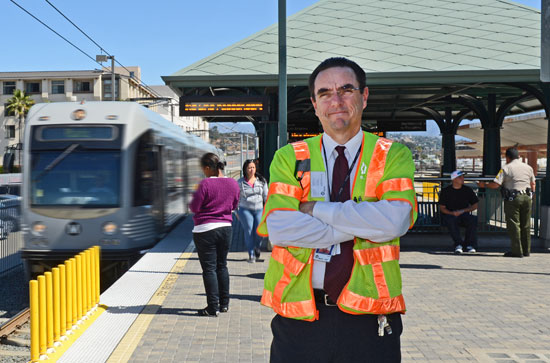
Metro's rail operations chief, Bruce Shelburne, says bike ridership on the trains has gone "sky high."
Bruce Shelburne is hoping for the best. But he’s bracing for “a learning experience.”
As Metro’s executive director for rail operations, Shelburne will have his hands full this Sunday, when the hugely popular CicLAvia winds its way for the first time from downtown Los Angeles to Venice, promising to pack the rail system with riders headed to points along the 15-mile route. At the same time, the Los Angeles Times Festival of Books and the Grand Prix of Long Beach will also be feeding crowds onto the rail lines.
Still, Shelburne, a 26-year Metro veteran, says he’s learned not to get overly stressed by the logistics and pitfalls of his job. “I’m learning to let go a little bit,” he says. “Otherwise you’re going to find yourself on the wrong end of a shovel, six-feet under.”
Shelburne expects one major CicLAvia hotspot to be the new Expo Line’s Culver City station, which, for now, is the closest stop to the sea. That end-of-the-line location will make it a major—and potentially clogged—entrance and exit point for people interested in traveling only along the route’s western end. Culver City’s elevated station might also complicate things because cyclists will have to carry bikes up and down stairs or crowd into elevators.
Increasing the potential congestion, CicLAvia has placed one of its “hubs” there to provide water, restrooms, and bike repairs, while Culver City and its businesses are planning a variety of entertainment options, including free massages and live music to complement food and shopping deals. A bike valet will help people make sure their wheels are secure while they browse the area.
Throughout Metro’s rapidly expanding rail system, Shelburne and his staff will also have to grapple with the reality that many CicLAvia passengers will be riding the rails for the first time and are unfamiliar with the agency’s TAP Card system, which can be confusing to the uninitiated.
“Trust me,” Shelburne says, “if that becomes a bottleneck, we’ll undo that real quick. We’ll address it with any means necessary to get people moving.”
Shelburne says that he sees CicLAvia and other major seam-stretching L.A. events as laboratories for lessons that can be applied in the future. For example, based on past CicLAvias, Shelburne says he’s doubling the number of trains on some lines. And while bikes are normally limited to two per train, Shelburne says, “we tend to look the other way on this kind of day.” In fact, Metro staffers will try to devote one car or maybe more per train to cyclists.
“It’s not all about the bikes,” Shelburne says. “We can’t take all the seats out. We have 100 million riders boarding the system annually and the majority of them don’t use bikes….The advantage is that bicyclists, especially the experienced ones, tend to work well with each other.”
(On Thursday, the regional rail service Metrolink announced it would be putting all 17 of its specially-outfitted “bike cars” into service on Sunday to serve the CicLAvia crowds. More information is here.)
While Shelburne is modest about his team’s successes managing past events, he’s particularly proud of one of his personal contributions—deploying Metro staffers to help people navigate the system and provide a human face to agency. Humor helps, too, he says. “If you’re not afraid to make a joke at your own expense, it goes a long way.”
On the future of bikes and trains in general, Shelburne sees a growing challenge and the need for a new relationship between cyclists and other passengers. “It seems like our bicycle ridership has really gone sky high,” he says.
Metro has already removed seats from older rail cars, and new cars will include additional accommodations for bicycles. But in the long term, Shelburne says, Metro will need to look at additional measures, such as arranging seats around the edges of cars to open more floor space.
While Shelburne admits he’s not one to jump on a bike very often, he does spend a plenty of time on the rails each day. He commutes from his home Oxnard to Union Station in downtown L.A.—a 70-mile trip that takes more than 90 minutes each way. On the way home, it’s a chance to catch up with work. But in the morning, he says, the smooth ride is the perfect opportunity for a pre-office nap.
“What rail buys,” he says, “is peace of mind and consistency. It just calms you down and you don’t have to worry about some of the idiots on the road.”
Venice welcomes CicLAvia—warily
April 18, 2013

A lone bike along the Venice boardwalk is certain to have plenty of company come Sunday's CicLAvia to the sea.
Danny Farahirad predicts Sunday’s CicLAvia will be “awesome.” The last time the cycling extravaganza took to the streets of Los Angeles, his family-owned Downtown L.A. Bicycles fixed more than 150 flat tires and rented about 40 bikes in a single day.
But Farahirad is in the central city, where the car-free event has been a rousing success for three years now. Less optimistic is Hyun Dong, who manages a t-shirt stand at the end of this weekend’s new route, on the Venice Boardwalk.
“Bicycles? Bad for business,” Dong sighs, mulling his customer-less shop from behind the cash register on a recent weekday. “Just like the events with the joggers. No one buys anything.”
As L.A.’s favorite car-free movable party ventures out of the city core on its first-ever push to the ocean from Downtown Los Angeles, a mixture of excitement and apprehension awaits on the city’s populous Westside. (Click here for a map.)
As many as 200,000 people are expected to participate in the event, which promises to be the biggest, longest CicLAvia so far; more than 15 miles of asphalt will close to motor vehicles from 10 a.m. to 3 p.m. to make way for a free-flowing crowd of cyclists, walkers, skaters, wheelchair riders, skateboarders and others.
Advance word of the event has been accompanied by high hopes that its street-fair atmosphere will continue to travel with it, but there also have been scattered concerns that it could deter sales and jam traffic in one of the densest areas of the city. Complicating the picture are lingering jitters from this week’s Boston Marathon bombing.
“There are nuts out there who are intent on hurting people,” worries Venice resident Linda Kadi, “and after what just happened, it’s scary to think about having a huge bunch of people here in one place.”
CicLAvia organizers say they expected Westside merchants and residents to need some reassurance, and that they have been doing outreach in the community for several months.
“It’s a new route,” says volunteer coordinator Martin Lopez-Iu of the Los Angeles County Bicycle Coalition. “We’ve never done this before, so some of the reactions have been kind of confused. When people in L.A. hear that you’re closing streets and taking away parking, it’s easy for them to think, ‘Oh, my God, you’re taking away business.’ But when people slow down, they’re actually more inclined to stop into their local coffee shop or restaurant.”
He notes that most communities are welcoming the excitement. For example, in Culver City, where the first phase of the new Expo Line ends, the Chamber of Commerce and Downtown Business Association have co-sponsored one of several “hubs” where participants can gather.
But at the end of Venice Boulevard, where the route empties into a parking lot abutting the Venice Boardwalk, shopkeepers predict that CicLAvia will draw foot traffic away from their wares on the weekend, when they make most of their sales.
“That’s gonna be a loss of fund-age, absolutely,” predicted a clerk selling glass pipes next to a marijuana dispensary who would identify himself only by his first name, Gary.
“And business has been slow already,” chimed in a neighboring jewelry merchant. “Even spring break came and went and I didn’t even notice. It was our worst spring break in 25 years.”
Lopez-Iu notes that Venice Boulevard is a popular attraction in its own right, and says CicLAvia organizers have worked with businesses before to overcome such worries. In 2011, for instance, merchants in the downtown garment and piñata districts complained that CicLAvia street closures would disrupt business on their busiest weekend day.
“Those guys do a lot of business on Sunday, and it requires people to come in in cars, and the first time we did the event there, they had a lot to say about it,” says Lopez-Iu. “So the next time, we worked with them. Some of them built bike-shaped piñatas that we promoted on our website. And we listed all the businesses there, and the fun things to do there. And they got a ton of business, because 100,000 new people had just found out where they could get piñatas and wholesale fabric in L.A.”
Organizers say that street closures will be less onerous than they might seem. For example, although much of Venice Boulevard will be taken over by CicLAvia, it will only be closed to motor vehicles on one side of the divider, and cars and trucks will be able to cut across the route in more than 30 places.
“The south side of Venice, from Crenshaw Boulevard west, will still be open to eastbound traffic,” says Lopez-Iu. “This isn’t going to bisect the city like with the marathon.”
He also notes that security will be ramped up in the wake of Monday’s bombing, not only for CicLAvia, but also for the Los Angeles Times Festival of Books and other events that are expected to draw crowds over the weekend. In fact, he says, so many deputies and police officers are being deployed that he’s had to muster extra yellow-shirted CicLAvia volunteers to prevent crowds from feeling intimidated.
“I try to balance the police presence with volunteer presence, to put out a friendlier face,” he says.
Meanwhile, CicLAvia fans are eagerly anticipating Sunday’s big ride—even if the event hits close to home. (For FAQs, click here.)
“I will be riding the entire length of it and getting all my friends to come,” vows John Kurtz, walking his dog, Delilah, outside their Venice Beach apartment. “I wish they would do it every weekend. It lessens the impact of the car culture and opens the streets up to people, and lets people know that they don’t have to drive everywhere, that the things they need are right in their neighborhood, a short bike ride away.”
Posted 4/18/13
Taking a bite out of animal cruelty
April 11, 2013
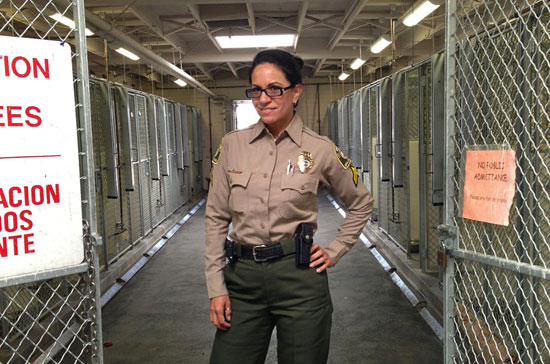
Abusers beware: Eva Montes and her crack team in the county animal control department are on the case.
What began 15 years ago simply as a promising job for a struggling single mom of three youngsters, has become a calling. “I am a voice for the animals,” says Eva Montes.
Those animals have come in all sizes and shapes, from furry to feathered, but they’ve suffered a common fate: they’ve been treated badly by people—sometimes through ignorance, sometimes with malice. And it’s not just about the animals.
“Most serial killers started with abusing animals,” Montes says, “and we have to put a stop to that early.”
Montes belongs to a select squad inside Los Angeles County’s Department of Animal Care & Control that investigates the agency’s most complex cases of animal neglect and cruelty. Called the Major Case Unit, its seven members tackle everything from highly organized pit bull and cockfighting rings to cat hoarders to single cases of heartbreaking—and criminal—abuse.
On Tuesday, she was among more than a dozen uniformed colleagues picked to represent the department before the Board of Supervisors as part of “Animal Control Officers Appreciation Week in Los Angeles County.” While the agency is best known for its shelter system and efforts to find adoptive homes for animals, the largely unsung detective work of its Major Case Unit, or MCU, is central to the agency’s mandate.
“By our very mission, we’re charged with protecting the public and protecting animals,” says Deputy Director Aaron Reyes, who oversees the unit. “One of the best ways we can do that is to investigate crimes of cruelty, abuse, neglect and illegal animal fighting.”
Reyes says the MCU was created more than a decade ago when it became clear that the massive volume of calls handled by animal control officers was preventing them from undertaking sustained and difficult investigations. Until last year, the MCU had been based in the original “pound master’s house” at the department’s first-ever facility, which opened in Downey in 1946. But Reyes says he thought it was crucial to get the team’s members “onto the front lines” and base them in various shelters, where they could initiate investigations more quickly and share their expertise and insights with other officers.
The idea to scatter the team was not met with enthusiasm.
“We were against it,” recalls Montes, who’s been in the unit for nearly three years. “We hung out together. We were family. But it’s worked out better.” Since being assigned to the Carson Animal Care Center, Montes says, she’s found potential abuse cases “that were slipping through the cracks” because some officers were not creative enough in their investigations or sufficiently trained to spot signs of less obvious abuse or neglect when people were bringing dogs to the shelter.
Since last July, Montes says she has, for the first time, initiated a number of investigations of people who’ve brought dogs to the facility, including a woman who recently turned in a pit bull that looked like it had been used for fighting. A warrant for her arrest was recently issued. Last November, Montes was instrumental in a joint investigation with the SPCA Los Angeles that led to a long list of cruelty charges filed by the district attorney’s office against the owner of a Gardena guard dog business.
Being assigned fulltime to the Carson shelter, which serves some of southern Los Angeles County’s most impoverished neighborhoods, has been a culture shock for Montes. Before her promotion to the MCU, she spent nine years in the county’s Agoura Animal Care Center, high in the mountains above Malibu. She calls it “the Club Med of shelters.” The dogs, she says, are mostly of the “frou-frou” variety, and volunteerism is robust, something for which she’ll always be grateful on a very personal level. During Montes’ tenure there, her 14-year-old daughter died from a form of bone cancer. Volunteers built a misting system to keep the animals cooler during the summer months and dedicated it with a plaque in honor of Montes’ daughter, Jessica.
“She really respected my job,” Montes says of her girl. “If she could only see me now.”
In contrast to the Agoura shelter, Montes’ current assignment has exposed her to some of the meanest dogs and toughest owners in the department’s jurisdiction, a swath of southern Los Angeles County where “gang members represent themselves with their dogs.” Sometimes, she says, packs of “dominant breed” dogs such as Rottweilers and pit bulls roam the streets. “It’s scary,” she says. “I worry about getting bit and never being able to work again.”
Montes says she’s received cooperation during her neighborhood investigations but has been told by some male officers that they’ve encountered resistance when responding to complaints, being warned: “Get off my property or I’ll shoot you.”
One of Montes’ colleagues in the Major Case Unit is Armando Ferrufino, who, like her, also works in the southern part of the county. An expert on cockfighting, he’s assigned to the Downey Animal Care Center. And like Montes, he also feels as though he’s a voice for the animals.
He tells the story of a man who, for months, allowed his Rottweiler, Duke, to deteriorate into a mass of tumors and sores, refusing to seek medical help despite the animal’s obvious suffering. Acting on a tip, animal control officers rescued Duke, but he was too far gone to save.
“I felt like the spirit of the animal was telling me to do the right thing, to investigate and get the whole truth,” Ferrufino says. “And I did.” The owner was charged with a felony and sentenced to three months in county jail.
Ferrufino, who joined the MCU in 2009, says one of the most sensitive assignments involves animal hoarders, mostly lonely elderly people whose homes are filled with scores of cats, a good number of them ailing. “In their mind,” Ferrufino says, “they believe they are doing the right thing—showing them love—but it gets to the point where they can’t take care of them.”
If the neglect is severe, he says, then charges are pursued. Authorities also provide referrals for counseling. What’s more, the county has a program to help clean homes after animals have been removed during often tearful negotiations with owners. “It’s an illness,” Ferrufino says. “They’re not aware they’re doing something wrong.”
As difficult and wrenching as the work can be, Ferrufino says, he’s found his calling, too.
“Every day I come to work, I’m happy,” he says. “You don’t know what’s going to happen next, from hoarders to horses to cockfights.”
Montes agrees. “Some people like to stay in the shelter environment. But I saw other officers out there getting justice and I said: ‘That’s what I want to do.’ “
Posted 4/12/13
Next stop? A milestone in public art
April 11, 2013
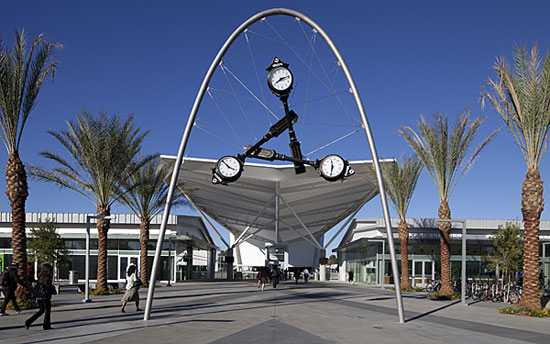
Donald Lipski's "Time Piece," part of Metro's signature art collection, greets bus travelers at the El Monte station.
As art collections go, it’s impressive, from famed sculptor Jonathan Borofsky to activist/artist Judy Baca to renowned Eastside painter Frank Romero.
The catch? You have to be traveling to see it. Oh, and a lot of it is literally underground.
The sprawling exhibition of public art that Metro has built in L.A. County’s subway, bus and commuter rail stations will celebrate its 25th anniversary next year. (Take a virtual tour in our gallery below.)
Launched in 1989 with a half-percent set-aside from rail construction costs, Metro’s award-winning collection of public transit art now encompasses work by some 120 artists in 100 stations, plus posters, photography, poetry and other temporary installations by another 180 artists. Last week, eight California artists were selected to create work for the second phase of the Expo Line, which will run to Santa Monica from the end of the first segment at Culver City.
“Art brings a unique vibrancy and vitality to L.A.’s Metro system,” says Maya Emsden, deputy executive officer for creative services at Metro, who is one of a handful of co-authors on a forthcoming American Public Transportation Association “best practices” paper on integrating art into public transit.
“Art was an integral part of the Metro rail planning process from the very start.”
Metro’s collection kicked off in 1990 with a now-highly-collectible poster by Romero to commemorate the opening of the first Metro rail line. That inaugural artwork, which depicts an old Red Car morphing into the Blue Line as classic cars, blimps and airplanes whiz around it, was followed the next year by “Unity,” a glowing, blue-and-white permanent installation of 82 fiber-optic light panels in the subway tunnel between the Metro Center and Pico Stations by Thomas Eatherton, an artist from Santa Monica.
That piece led in 1993 to a series of now-iconic permanent artworks: Borofsky’s “I Dreamed I Could Fly,” a collection of life-size fiberglass figures suspended from the ceiling of the Civic Center station; Terry Schoonhoven’s Union Station mural of “time-scapes” from Spanish galleons to Carole Lombard, sitting on a suitcase; Joyce Kozloff’s ceramic tile “film strip” murals in the 7th Street/Metro Center station; Stephen Antonakos’ hanging neon artworks at the station below Pershing Square.
Since then, the program has expanded with L.A.’s transit system, says Emsden; the new commissions for Phase 2 of the new Expo Line were selected from some 400 submittals and include such artists as Shizu Saldamando, Abel Alejandre, Susan Logoreci, Nzuji de Magalhaes, Constance Mallinson, Carmen Argote, Judithe Hernandez and Walter Hood.
Though the half-percent of construction costs that L.A. reserves is substantially smaller than transit art set-asides in Boston, New York, Portland, and most other cities with such programs, Metro has been able to stretch its allotment by integrating the artworks as much as possible into the station construction.
“One of the ways we’re able to maximize the limited budget is through early involvement in the project,” says Emsden. “This also ensures important art-related things like lighting are integrated into the station plans.”
The added efficiency of building art into a station, as opposed to going back later and retrofitting, is just one of a number of art lessons Metro has learned in the past 24-plus years. Art program staffers have learned to work closely with architects, engineers and maintenance staff to situate pieces so that maintenance of the art is taken into consideration—a matter that can be trickier in, say, a rail station than in a museum.
“The Borofsky piece, ‘I Dreamed I Could Fly’, is one of my absolute favorites,” says Emsden. “But if we were to do it again we’d make sure the figures, which are actually self-portraits of the artist, were hung in a way that we could lower them for cleaning.” The flying fiberglass figures—like everything else in the stations—get covered over time with magnetic steel transit dust that can only be removed with specialized equipment and cleansers, says Emsden.
“So every five years or so, we get up there and clean them between 2 a.m. and 4 a.m.”
Another lesson: Some kinds of art fare better in transit settings than others.
Eatherton’s 1991 light piece, for instance, has been out of order for about six years, due to the technical challenges of maintaining aging electrical elements in a hard-to-reach space. Part of a Jacqueline Dreager sculpture at the Blue Line’s Wardlow station had to be taken out because it was too close to a landscaping sprinkler and was slowly being decomposed by the water. A set of Gilbert Lujan benches at the Hollywood/Vine station had to be refurbished and then eventually removed altogether because vandals kept tagging and carving their initials into the sculpted bench backs.
However, the vast majority of the Metro projects have fared well, says Emsden, adding that even delicate images have been made transit-worthy by rendering them in materials that are sturdy enough for public artwork.
“We’ve commissioned a couple of artists whose whole body of work is on paper, but there are some amazing artisans in L.A. and elsewhere who can translate those artist’s visions into very durable materials,” says Emsden.
For example, one Canadian studio that specializes in mosaics has made detailed lino-cut prints by Sonia Romero and Daniel Gonzalez, paintings by Samuel Rodriguez and photos by Pitzer College associate art professor Jessica Polzin McCoy into intricate Metro panels made of ceramic tile.
Meanwhile, she says, the program has yielded some pleasant surprises. One was the groundswell of interest among local culture enthusiasts asking to do guided art tours. The result, in 1999, was a Docent Council whose volunteers have introduced more than 30,000 people to the art of the Metro system. Notes Emsden: “We’re the only transit agency with volunteer docents and free Metro art tours.”
Perhaps the nicest surprise, however, has been the way in which some Metro pieces have worked their way, just by word of mouth, into the public imagination. “There’s a light piece by the artist Bill Bell that, if you say a secret word into a tiny hole in the wall at the top of the escalators that go down to the Red and Purple Lines at Union Station, the piece will speak back to you,” Emsden says.
There’s no sign. There are no instructions. The artist, by design, held back the “secret word” (the names of any of the various celebrities depicted, from Rin Tin Tin to Dizzy Gillespie) and left no clue that any extra magic might be found there. “But I can’t tell you how many times I’ve seen someone going past there—a security guard, a commuter, a business person—and saying to the person next to them: ‘You gotta check this out!’ ”
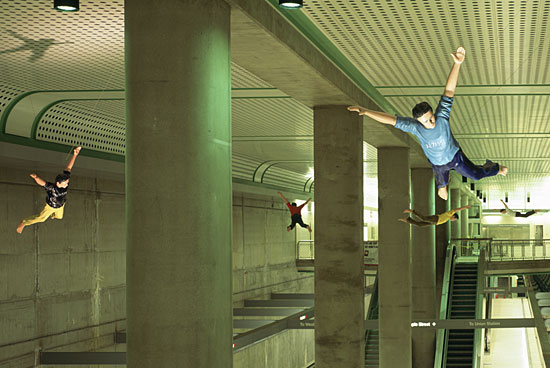
Jonathan Borofsky’s “I Dreamed I Could Fly” is an iconic—though hard to clean—part of the Civic Center Station.
Public art and public transit come together in the following gallery. All images courtesy Metro.
Posted 4/11/13
Puppets come out to play in L.A.
April 4, 2013
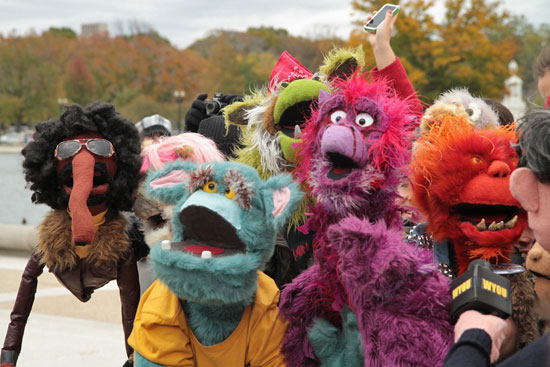
The "Million Puppet March" in Washington had a goal of saving PBS funding. Only fun is on the agenda for L.A. Puppet Fest.
Stretching their wooden arms, the sleeping puppets of Los Angeles are ready to take center stage.
The puppetry community is full of characters—and not just the wooden or fuzzy varieties. From old-school marionettists to modern dramatists who manipulate 10-foot monstrosities in teams of three, they’re as diverse as the city they live in.
Last September, Joe Smoke of the City of Los Angeles Department of Cultural Affairs approached Maria Bodmann, an expert in the thousand-year-old art of Balinese shadow puppetry. Together, they pulled a few strings and organized a meeting of L.A. puppeteers with the goal of producing a citywide festival. This month, their plans will come to life at the inaugural L.A. Puppet Fest.
Bodmann hopes the festival will expose people to the many varieties of puppetry.
“People think fuzzy things with eyeballs, but that’s just one little bit of puppetry,” Bodmann said. “There are other types that address issues that aren’t really for kids. The stuff I do is connected to religious rituals. I can’t really do it for birthday parties.”
Pre-festival activities have already begun. From Thursday through Saturday, Rogue Theaters presents “Songs of Bilitis,” a mature audiences-only puppet rendition of the French erotic novel by Pierre Louÿs. The official opening takes place Sunday, April 7, at the Skirball Cultural Center and will feature puppet-making, performances and storytelling. After that, there will be performances by the Bob Baker Marionette Theater, a lecture on puppet history and puppet films and classes. The festival wraps up on April 28 with “L.A.’s largest-ever puppet parade” and closing ceremony at the Third Street Promenade in Santa Monica. See the website for a full schedule of events.
Michael Earl, a co-founder of the Puppet School who had a turn playing “Mr. Snuffleupagus” on Sesame Street a few decades back, said professional puppeteers have been through tough times in recent years.
“When Jim Henson was alive, there was a lot of puppetry happening; they had to train more puppeteers because there were not enough,” Earl said. “Then, 3D animation was invented and it slowly started to replace puppetry jobs.”
But Earl and his contemporaries see puppets making a comeback, due partly to the success of live stage productions like The Lion King and popular box office offerings including Where the Wild Things Are and 2011’s The Muppets.
Cue the L.A. Puppet Fest, which is being called L.A.’s first-ever citywide puppet festival—a description reached amid controversy.
“There is inter-puppet genre conflict,” said Michael Bellavia, who is organizing the puppet parade and closing ceremony. “The puppet geeks, they got all up in arms when this was billed as the first puppet festival.”
Accounts vary. Some point out smaller-scale annual events by the Los Angeles Guild of Puppetry. Alan Cook, co-founder of the guild and curator of the International Puppetry Museum in Pasadena, is a revered patriarch of the puppetry community. He recalls a major, national festival held at UCLA back in 1957. Recorded puppet history in Los Angeles dates back at least 100 years, he said. Worldwide, forms of puppetry go back millennia and represent some of the most respected cultural art forms.
The guild’s current president, Christine Papalexis, said contention among puppeteers is common because they’re artists.
Despite their differences on the minutiae, everyone agrees the festival should be as inclusive as possible. They’re united by a love of puppetry that, for many, began with their first toy puppet in early childhood.
That inclusivity extends to the audience, who will be invited to make their own puppets and learn puppetry skills at some of the events. The L.A. Puppet Fest Parade, for example, will have a puppet-making station on site, and organizers say it’s fine if people just want to draw eyes and a mouth on their hands.
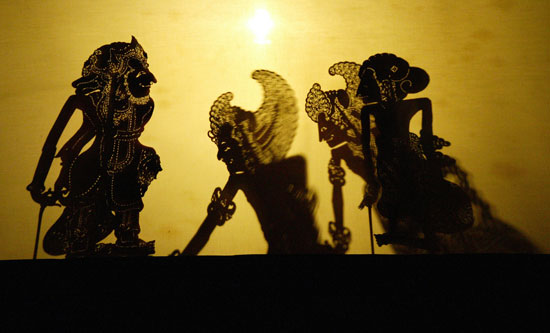
Carved rawhide shadow puppets act out a scene involving the heroic Pandawa brothers of the Mahabharata, a Sanskrit epic from ancient India.
Posted 4/4/13




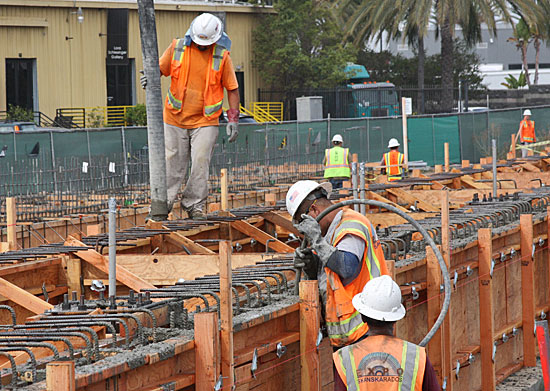
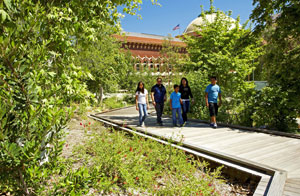
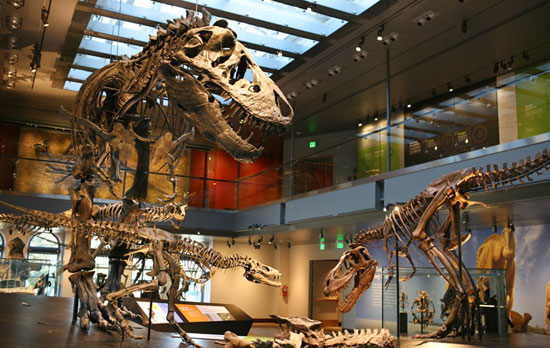
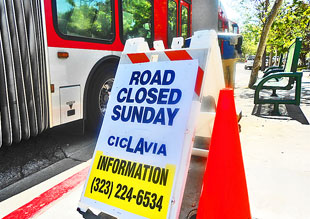
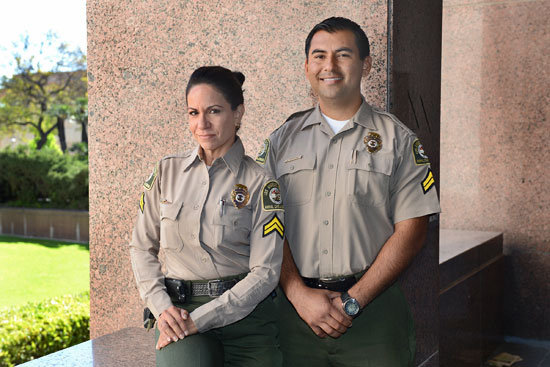
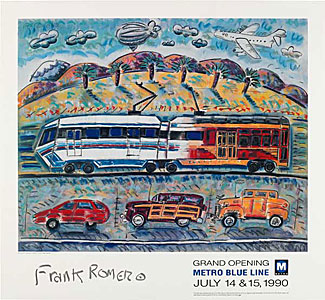

















 405 bridge work causes a stink
405 bridge work causes a stink

